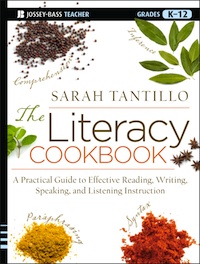Good Recipes for ELA Classrooms
The Literacy Cookbook: A Practical Guide to Effective Reading, Writing, Speaking, and Listening Instruction
by Sarah Tantillo
(Jossey-Bass, 2013 – Learn more)
When I think of a cookbook, the first thing that comes to mind is the homegrown kind, with tested recipes from the front-line experts — mothers, fathers, grandparents, aunts and uncles. I think of the memories that go along with the recipes in the cookbook and the family history that created the recipes.

Sarah Tantillo is no stranger to education and assessments. Before becoming a literacy consultant, Ms. Tantillo taught high school English and humanities in suburban and urban New Jersey public schools for 14 years. One of the highlights of her career was when she chaired the Humanities Department at North Star Academy Charter School in Newark and her students achieved a 100% passing rate on the Language Arts/Literacy section of the HSPA in 2006 and 2007.
What’s cooking?
Picture a group of teachers sitting around the kitchen table — “teacher talking” — which is something we do well and often. When you read the book, you feel as if you are in someone’s kitchen, sharing recipes for student success. Many of Tantillo’s ideas are not only tried and tested ideas but well aligned with the English Language Arts Common Core Standards.
She begins her book by discussing the comprehension process and the importance of assessing students’ background knowledge so they can become fluent readers of complex text. Her ideas help the teacher who laments that “the students can read fluently yet don’t comprehend what they have read.” Tantillo reawakens us to facts we may have known but stored in our “teacher’s file cabinet” and suggests effective ways we can apply them to the students in our care.
She stresses the importance of exposing our students to an enriched vocabulary as we seek to increase understanding and comprehension. Without this word sense, they will struggle to make meaning from what they are reading. As I read this section, I realized that no matter how rich the text is — or how “up to date” it may be in terms of social issues and time periods — students will continue to skim the surface of the material until we provide them with background knowledge and frequent practice in explaining their thinking.
Next, she identifies the characteristics of different types of readers and explains the methods to use when teaching students to read strategically. The section on writing describes what students struggle with most and offers practical techniques for overcoming these challenges. The book also includes great suggestions for training students to listen and speak more effectively.
(READ an article by Sarah Tantillo, Teaching Argument vs. Evidence, here at MiddleWeb.)
Side dishes
One of the added bonuses of the book is a free trial subscription to The Literacy Cookbook Website, which contains hundreds of useful lessons and tools to support literacy instruction. The 30 day trial period goes by very quickly, alas, and once it ends you no longer have access unless you buy an annual subscription. Fortunately, the price is discounted 50% if you own the book ($25 instead of $50).
Ms. Tantillo’s blog (no subscription required) is rich with classroom tested techniques for enhancing literacy teaching for all grade levels and subject areas, as well as links to professional articles and groups such as the Smarter Balanced Assessment Consortium, which is developing Common Core test items in ELA and mathematics and is now making sample items available.
If Tantillo’s book has a fault, it’s that she has erred on the side of abundance. It is packed with so many ideas that it can be overwhelming on a first reading — like walking up to the buffet table and being tempted to try everything on display. But if you take it slow, and begin with a few recipes that interest you most, you’ll find it a superior resource. Each chapter contains research based ideas of how to make literacy authentic and fun at the same time. And with its close attention to the Common Core standards, its recipes will serve novices and veterans alike.
Linda Biondi is fifth grade teacher at Pond Road Middle School in Robbinsville, New Jersey, and a Teacher Consultant with the National Writing Project.




































Many thanks to Linda for this thoughtful, comprehensive review. I really appreciate the support and encouragement. I hope many readers will partake of the recipes! Cheers, Sarah Tantillo
Thank you! I love the book and enjoy following your blog.